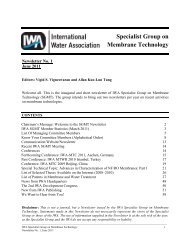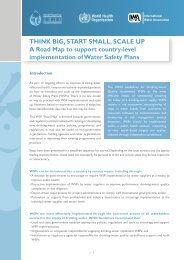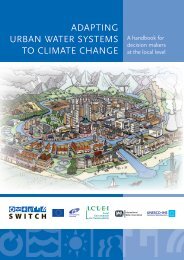Sanitation 21 planning framework - IWA
Sanitation 21 planning framework - IWA
Sanitation 21 planning framework - IWA
- No tags were found...
You also want an ePaper? Increase the reach of your titles
YUMPU automatically turns print PDFs into web optimized ePapers that Google loves.
<strong>Sanitation</strong> <strong>21</strong>Using the Framework – describing SANITATION SYSTEM/ OPTIONSTable7bStep CONTEXTSANITATION SYSTEM/OPTIONSFIT FOR PURPOSE?FactorInterests/objectivesExternalFactorsCapacity<strong>Sanitation</strong>ElementsManagementDoes it meetObjectives?Do Managementrequirementsmatch?Will it/does itwork?HouseholdNeighbourhoodWard/DistrictCityBeyond thecityStep Five(a) Analysis of existing systemsWhere there is an existing system,‘map’ this against the domainsidentified. Disaggregate the systemso it is clear what elements existand/or function in each domain. Inthis way for example the existenceof a wastewater treatment plant canbe separated from the households,and the existence of put latrines canbe separated from the downstreamareas.(b) New systems/ development ofsystems over timeWhere new systems are beingproposed, the various options can bemapped in turn against the domainsidentified.Step Six (existingand new systems)Identify IN DETAILthe managementrequirements for thesystems disaggregatedacross each domain.These requirementsinclude skills,manpower, time,money, tools, etc.checklist against which later proposals can bemeasured. Some assessment of the externalfactors which drive decisions and priorities at eachlevel will also help at the later stages of <strong>planning</strong>.Finally, having separated out various interestgroups and disaggregated these across domainsthe planner can make a realistic assessmentof capacities at each level – thus preparing theground for sensible decision making about shortterm implementation and long term managementof sanitation systems.At this stage the planner can also review howinterests, external factors and capacities are likelyto change over time2. <strong>Sanitation</strong> Systems/ Options(see Table 7(b))Having put in place a relatively sophisticatedinstitutional <strong>framework</strong>, sanitation systems (eitherexisting or proposed) can be ‘mapped’ againstit. This means that each element of the system(collection, transport, treatment, disposal, re-useetc) can be accurately located in the relevantdomain of the city and assessed against theprevailing and likely future context within thatdomain. This approach forces the planner toconsider the implications of technical decisionsagainst the full range of interests, external driversand capacities in the city – allowing a more realistic– 27 –
















